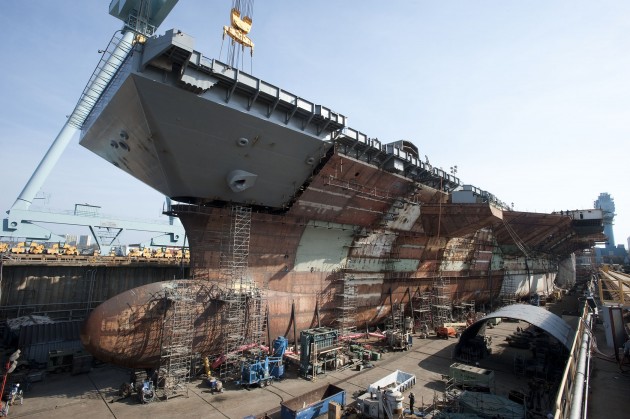
The $13 billion supercarrier USS Ford under construction in Newport News, Va.
WASHINGTON: Navy readiness won’t fully recover from the second-order effects of the 2013 sequester for another year, the Chief of Naval Operations said this morning — and if the Budget Control Act cuts (known as sequestration) return in full force for fiscal year 2016, the nation might lose two of its five remaining major shipyards.
“I worry about the shipbuilding industrial base,” Adm. Jonathan Greenert said at the Brookings Institution. If sequestration forces steep cuts to the Navy’s shipbuilding account — which Congress has actually been pretty adamant about protecting; more on that below — the impact on the size of the fleet “would take years to manifest,” he said: Ships last for decades, so building fewer today generally comes back to bite you in a generation, not immediately. “But more importantly,” the admiral went on, “there’s some likelihood we lose one or two [ship] builders, and we only have five.”

Adm. Jonathan Greenert
Bath Iron Works in Maine, Electric Boat in Connecticut, Newport News in Virginia, Ingalls in Mississippi, and NASSCO in California: These are the “Big Five,” down from the “Big Six” since the closure of Avondale in Louisiana. (Concentrating the industry even more, Ingalls and Newport belong to Huntington-Ingalls Industries; the other three yards all belong to General Dynamics). Could we really go down to a Big Four or even a Big Three? Expert opinion was split.
“No,” said Loren Thompson, one of the best-connected industry consultants and analysts in town. “In terms of resources, you could certainly make a case for reducing the number of shipyards. However, in terms of the politics, there’s no chance at all a shipyard is going away.”
“It definitely strikes me as a possibility,” argued Andrew Hunter, who recently left the Pentagon, where he was the highly regarded director of the Joint Rapid Acquisition Cell. Hunter now heads defense industrial base initiatives at the Center for Strategic and International Studies. He’s most worried about NASSCO, which builds relatively modest supply ships, oilers and the like rather than combat craft. “The yard itself could be at risk, just because of the nature of the work they do,” he told me. “You don’t have that steady stream of ships every year the way you do with destroyers and subs.”
“NASSCO does have some other revenue sources” besides the government, Hunter told me. “It’s been painful and a little bit of a high wire act, but they’ve managed to get by with a pretty limited stream of work from the Navy.”
Perhaps more likely than losing a yard outright, Hunter said, would be to lose what little competition is left in the shipbuilding industry as each yard streamlines its workforce and facility to handle just one kind of ship. While nuclear aircraft carriers are made exclusively at Newport News and amphibious assault ships at Ingalls, both Electric Boat and Newport build submarines, while both Bath and Ingalls build destroyers.
Such competition can’t be too cutthroat, since the Navy doesn’t want either yard to go out of business, but it still encourages the yards to control costs and invest in productivity, Hunter argued. “If you were to lose that — and it might be difficult for the Navy to maintain the up front costs of competition on those ship types — you’d get a short-term savings but at a significant long-term cost to the department,” he said. “It’s almost like the payday lender approach to national security.”
The Navy could still build all the types of ships it needs at a smaller number of yards if you picked the right yards to keep. In theory, Loren Thompson said, “you could execute most of the shipbuilding program just at Newport News,” which is the only irreplaceable yard because it’s the only one able to build nuclear-powered aircraft carriers. “The problem is it [shipbuilding] would cease to have a political base in the Congress if you did that.”
Avondale died because of “an internal management decision” at then-owner Northrop Grumman, which decided to consolidate its Gulf Coast shipbuilding operations down the shore at nearby Ingalls, Thompson said. So the Louisiana yard’s fate is no precedent for what would happen under sequester.
“It would be a losing proposition for the Navy to eliminate shipyards as a way of trying to economize,” Thompson said: Any theoretical cost savings would be outweighed by the loss of congressional support for the shipbuilding budget, which would decline. Instead, the Navy would be much more likely to spread the work a little thinner to keep all the yards in business — and their congressional delegations on board.
“The range of ships that the Navy can afford under sequestration is more than sufficient to keep half a dozen or more shipyards functioning with all the necessary skills,” said Thompson, including the two mid-tier shipyards that build the Littoral Combat Ship (LCS): Marinette in Wisconsin and Austal in Alabama. And that’s assuming that shipbuilding is cut proportionately to the defense budget as a whole, far from a foregone conclusion given both its political support in Congress and its strategic importance to the “Pacific pivot.”
“The shipbuilding account is approximately three percent of defense spending; there’s no law that says it has to stay at three percent,” Thompson said. “In fact it will have to go up to accommodate the Ohio-replacement [ballistic missile submarine].”
So if talk of losing a major shipyard is more stop-sequester scare tactics than sober analysis, what should we really be worried about? Greenert’s full remarks this morning make that pretty clear. One worry is the loss of existing competition, as Hunter outlined. Another is the potential damage to multi-year procurement (MYP) contracts.
Negotiating on multiple ships at once gets the Navy a better deal. Splitting a big buy, say, 60-40 between two yards also allows for some measure of competition, since the Navy can’t afford (and politics won’t allow) any yard going out of business after losing a winner-take-all contract. But MYPs require stable, predictable funding to negotiate, let alone execute.
The fleet is increasing in size (for now), Greenert said this morning, “and we’re growing because we’ve had a stable shipbuilding plan now for about five, six, seven years. That has produced ships and shipbuilding projects that are coming in on time and under budget because we have a competitive situation and a multi-year procurement.”
Then there’s the danger to smaller companies, ones which whose failure is politically possible. “You eliminate your mid-grade vendors, people that build specialized valves, circuits, and other specialized items, especially in the nuclear field,” said Greenert, a career nuclear submariner himself. Such small components can be critical to a warship’s full functioning: For want of a nail, after all, a battle can be lost.
Finally, there’s the impact on maintenance — conducted by a mix of public and private-sector yards — which ultimately impacts readiness and morale. The sudden onset of the sequester in 2013, compounded by a government shutdown, badly disrupted operations, maintenance, and training across all the services. In the Navy, Greenert said, “we…stopped work on some of the projects in the shipyards: the Vinson we slowed down dramatically, the Reagan, and the George Herbert Walker Bush,” just to name the nuclear carriers affected.
Even when the funding started to flow again, even with extra money for overtime work, it was impossible to entirely make up for lost time. Ships in maintenance took longer to get finished; ships at sea had to stay deployed longer because their replacements weren’t ready — and when they did get their turn in the yards, they needed more maintenance than expected because they’d been driven harder than planned.
The knock-on effects of the 2013 sequester are still being felt across the Navy, Greenert said. That wears on not just ships but sailors. Deployments that are normally six or seven months are now routinely extended to eight or nine: “That’s not sustainable,” he said. “[But] we’ve got another year — Vinson will be out there eight and a half months — of these longer deployments.”
Another year, that is, if sequestration doesn’t return in 2016 — as is currently the law. The question is whether the new Congress being elected today can change that.
SECNAV floats idea of co-production with foreign shipyards
Del Toro has repeatedly praised shipbuilders in South Korea and Japan for their abilities to keep construction efforts on time.


























